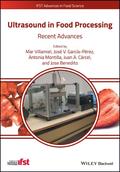Ultrasound in Food Processing
Recent Advances
IFST Advances in Food Science

1. Edition May 2017
544 Pages, Hardcover
Wiley & Sons Ltd
Part I: Fundamentals of ultrasound
This part will cover the main basic principles of ultrasound generation and propagation and those phenomena related to low and high intensity ultrasound applications. The mechanisms involved in food analysis and process monitoring and in food process intensification will be shown.
Part II: Low intensity ultrasound applications
Low intensity ultrasound applications have been used for non-destructive food analysis as well as for process monitoring. Ultrasonic techniques, based on velocity, attenuation or frequency spectrum analysis, may be considered as rapid, simple, portable and suitable for on-line measurements. Although industrial applications of low-intensity ultrasound, such as meat carcass evaluation, have been used in the food industry for decades, this section will cover the most novel applications, which could be considered as highly relevant for future application in the food industry. Chapters addressing this issue will be divided into three subsections: (1) food control, (2) process monitoring, (3) new trends.
Part III: High intensity ultrasound applications
High intensity ultrasound application constitutes a way to intensify many food processes. However, the efficient generation and application of ultrasound is essential to achieving a successful effect. This part of the book will begin with a chapter dealing with the importance of the design of efficient ultrasonic application systems. The medium is essential to achieve efficient transmission, and for that reason the particular challenges of applying ultrasound in different media will be addressed.
The next part of this section constitutes an up-to-date vision of the use of high intensity ultrasound in food processes. The chapters will be divided into four sections, according to the medium in which the ultrasound vibration is transmitted from the transducers to the product being treated. Thus, solid, liquid, supercritical and gas media have been used for ultrasound propagation. Previous books addressing ultrasonic applications in food processing have been based on the process itself, so chapters have been divided in mass and heat transport, microbial inactivation, etc. This new book will propose a revolutionary overview of ultrasonic applications based on (in the authors' opinion) the most relevant factor affecting the efficiency of ultrasound applications: the medium in which ultrasound is propagated. Depending on the medium, ultrasonic phenomena can be completely different, but it also affects the complexity of the ultrasonic generation, propagation and application.
In addition, the effect of high intensity ultrasound on major components of food, such as proteins, carbohydrates and lipids will be also covered, since this type of information has not been deeply studied in previous books.
Other aspects related to the challenges of food industry to incorporate ultrasound devices will be also considered. This point is also very important since, in the last few years, researchers have made huge efforts to integrate fully automated and efficient ultrasound systems to the food production lines but, in some cases, it was not satisfactory. In this sense, it is necessary to identify and review the main related problems to efficiently produce and transmit ultrasound, scale-up, reduce cost, save energy and guarantee the production of safe, healthy and high added value foods.
Epilogue
Preface
Part 1. Fundamentals of ultrasound
Chapter 1. Basic principles of ultrasound: Definition of ultrasound, frequency ranges, general applications depending on the frequency, main involved mechanisms
Part 2. Low intensity ultrasound applications
Section 2.1. Food and process control
Chapter 2. Ultrasonic particle sizing in emulsions
Chapter 3. Ultrasonic applications in bakery products
Chapter 4. Characterization of meat products by using ultrasound
Chapter 5. The application of ultrasonics for oil characterization (
Chapter 6. Bioprocess monitoring by using low-intensity ultrasound: measuring transformations in liquid composition
Section 2.2. New trends in ultrasonic non-destructive testing
Chapter 7. Air-coupled ultrasonic transducers
Chapter 8. Acoustic microscopy
Part 3. High intensity ultrasound applications
Section 3.1. Ultrasound applications in liquid systems
Chapter 9. Effects on microorganisms and enzymes. Manothermosonication
Chapter 10. Ultrasonic preparation of food emulsions
Chapter 11. Osmotic dehydration and Blanching. Ultrasonic pretreatments.
Chapter 12. Ultrasonically assisted extraction in food processing and the challenges of Integrating Ultrasound into the food
Section 3.2.Ultrasound applications in gas and supercritical fluids systems
Chapter 13. Ultrasonic transducers for solid transport by air-levitation
Chapter 14. Ultrasonically assisted drying. High and low temperature processes
Chapter 15. Combined use of high intensity ultrasound and supercritical fluids technologies for inactivation of microorganisms
Section 3.3. Effect of ultrasound on food constituents
Chapter 16. Impact of high-intensity ultrasound on protein structure and functionality during food processing
Chapter 17. Ultrasound effects on processes and reaction involving carbohydrates
Chapter 18. Effect of ultrasound on the physicochemical properties of lipids
Chapter 19. Effect of ultrasound on anthocyanins
Index
Mar Villamiel and Antonia Montilla, Department of Bioactivity and Food Analysis, Institute of Food Science Research (CSIC-UAM), Spain
José V. García-Pérez, Juan A. Cárcel, and Jose Benedito Analysis and Simulation of Agrofood Processes Group (ASPA), Food Technology Department, Universitat Politècnica de València, Valencia, Spain


